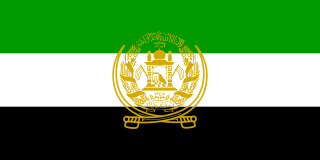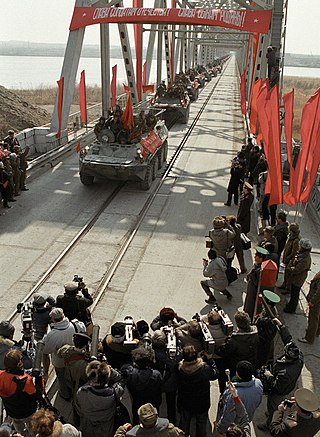
Gulbuddin Hekmatyar is an Afghan politician, former mujahideen leader and drug trafficker. He is the founder and current leader of the Hezb-e-Islami Gulbuddin political party, so called after Mohammad Yunus Khalis split from Hezbi Islami in 1979 to found Hezb-i Islami Khalis. He has twice served as Prime Minister during the 1990s.
The following lists events that happened during 1991 in Afghanistan.
The following lists events that happened during 1986 in Afghanistan.

The Islamic State of Afghanistan was the government of Afghanistan that was established by the Peshawar Accords of 26 April 1992 by many, but not all, Afghan mujahideen parties, after the fall of the socialist government. Its power was limited due to the country's second civil war, which was won by the Taliban, who took control of Kabul in 1996. The Islamic State then transitioned to a government in exile and led the anti-Taliban Northern Alliance. It remained the internationally recognized government of Afghanistan at the United Nations until 2001, when the Transitional Islamic State of Afghanistan was created and an Afghan Interim Administration took control of Afghanistan with US and NATO assistance following the overthrow of the first Taliban government.

Fazal Haq Khaliqyar was an Afghan politician, who briefly served as the Chairman of the Council of Ministers of the Republic of Afghanistan.

Abdul Haq was an Afghan mujahideen commander who fought against the Soviet-backed People's Democratic Party of Afghanistan, the de facto Afghan government in the 1980s. He was killed by the Taliban in October 2001 while trying to create a popular uprising against the Taliban in Afghanistan in the wake of the September 11th attacks.

The 1989–1992 Afghan Civil War took place between the Soviet withdrawal from Afghanistan on 15 February 1989 until 27 April 1992, the day after the proclamation of the Peshawar Accords proclaiming a new interim Afghan government which was supposed to start serving on 28 April 1992.

The 1992–1996 Afghan Civil War took place between 28 April 1992—the date a new interim Afghan government was supposed to replace the Republic of Afghanistan of President Mohammad Najibullah—and the Taliban's conquest of Kabul establishing the Islamic Emirate of Afghanistan on 27 September 1996.

The Battle of Kabul was a series of intermittent battles and sieges over the city of Kabul during the period of 1992–1996.
The following lists events that happened during 1987 in Afghanistan.
The following lists events that happened during 1988 in Afghanistan.
The following lists events that happened during 1989 in Afghanistan.
The following lists events that happened during 1992 in Afghanistan.

The final and complete withdrawal of the 40th Army from Afghanistan began on 15 May 1988 and ended on 15 February 1989, under the leadership of Colonel-General Boris Gromov. The Soviet military had been one of the main combatants in the Soviet–Afghan War since its beginning in 1979.

Afghanistan–Pakistan relations refer to the bilateral ties between Afghanistan and the Islamic Republic of Pakistan. In August 1947, the partition of British India led to the emergence of Pakistan along Afghanistan's eastern frontier, and the two countries have since had a strained relationship; Afghanistan was the sole country to vote against Pakistan's admission into the United Nations following the latter's independence. Various Afghan government officials and Afghan nationalists have made irredentist claims to large swathes of Pakistan's territory in modern-day Khyber Pakhtunkhwa and Pakistani Balochistan, which complete the traditional homeland of "Pashtunistan" for the Pashtun people. Afghan territorial claims over Pashtun-majority areas that are in Pakistan were coupled with discontent over the permanency of the Durand Line, for which Afghanistan demanded a renegotiation, with the aim of having it shifted eastward to the Indus River. Territorial disputes and conflicting claims prevented the normalization of bilateral ties between the two countries throughout the mid-20th century. Further Afghanistan–Pakistan tensions have arisen concerning a variety of issues, including the Afghanistan conflict and Afghan refugees in Pakistan, water-sharing rights, and a continuously warming relationship between Afghanistan and India.

The Democratic Republic of Afghanistan was the government of Afghanistan between 1978 and 1992. It was recognised diplomatically by only eight countries which were allies of the Soviet Union. It was ideologically close to and economically and militarily dependent on the Soviet Union, and was a major belligerent of the Afghan Civil War.

The Afghan conflict, also called Instability in Afghanistan is a series of events and wars that have kept Afghanistan in a near-continuous state of armed conflict since the 1970's. The country's instability began after the collapse of the Kingdom of Afghanistan in the 1973 coup d'état; with the overthrow of Afghan monarch Mohammed Zahir Shah, who reigned for almost forty years, Afghanistan’s relatively peaceful period in modern history came to an end. The triggering event for the first major war in Afghanistan during this period was the Saur Revolution of 1978, which overthrew the Republic of Afghanistan and established the Democratic Republic of Afghanistan. Rampant post-revolution fighting across the country ultimately led to a pro-government military intervention by the Soviet Union, sparking the Soviet–Afghan War in the 1980s.

The Inter-Services Intelligence (ISI) intelligence agency of Pakistan has been accused of being heavily involved in covertly running military intelligence programs in Afghanistan since before the Soviet invasion of Afghanistan in 1979. The first ISI operation in Afghanistan took place in 1975. It was in "retaliation to Republic of Afghanistan's proxy war and support to the militants against Pakistan". Before 1975, ISI did not conduct any operation in Afghanistan and it was only after decade of Republic of Afghanistan's proxy war against Pakistan, support to militants and armed incursion in 1960 and 1961 in Bajaur that Pakistan was forced to retaliate. Later on, in the 1980s, the ISI in Operation Cyclone systematically coordinated the distribution of arms and financial means provided by the United States Central Intelligence Agency (CIA) to factions of the Afghan mujahideen such as the Hezb-e Islami (HeI) of Gulbuddin Hekmatyar and the forces of Ahmad Shah Massoud whose forces would later be known as the Northern Alliance. After the Soviet retreat, the different Mujahideen factions turned on each other and were unable to come to a power sharing deal which resulted in a civil war. The United States, along with the ISI and the Pakistani government of Prime Minister Benazir Bhutto became the primary source of support for Hekmatyar in his 1992–1994 bombardment campaign against the Islamic State of Afghanistan and the capital Kabul.

The 1990 Afghan coup d'etat attempt occurred on March 6, 1990, when General Shahnawaz Tanai, a hardline communist and Khalqist who served as Minister of Defence, attempted to overthrow President Mohammad Najibullah of the Republic of Afghanistan. The coup attempt failed and Tanai was forced to flee to Pakistan.
In the spring of 1989, the Seven-Party Union in Peshawar supported by the Pakistani intelligence agency ISI attacked Jalalabad. The ISI's Director Gul wanted to see a mujahideen government over Afghanistan, led by Hekmatyar.











